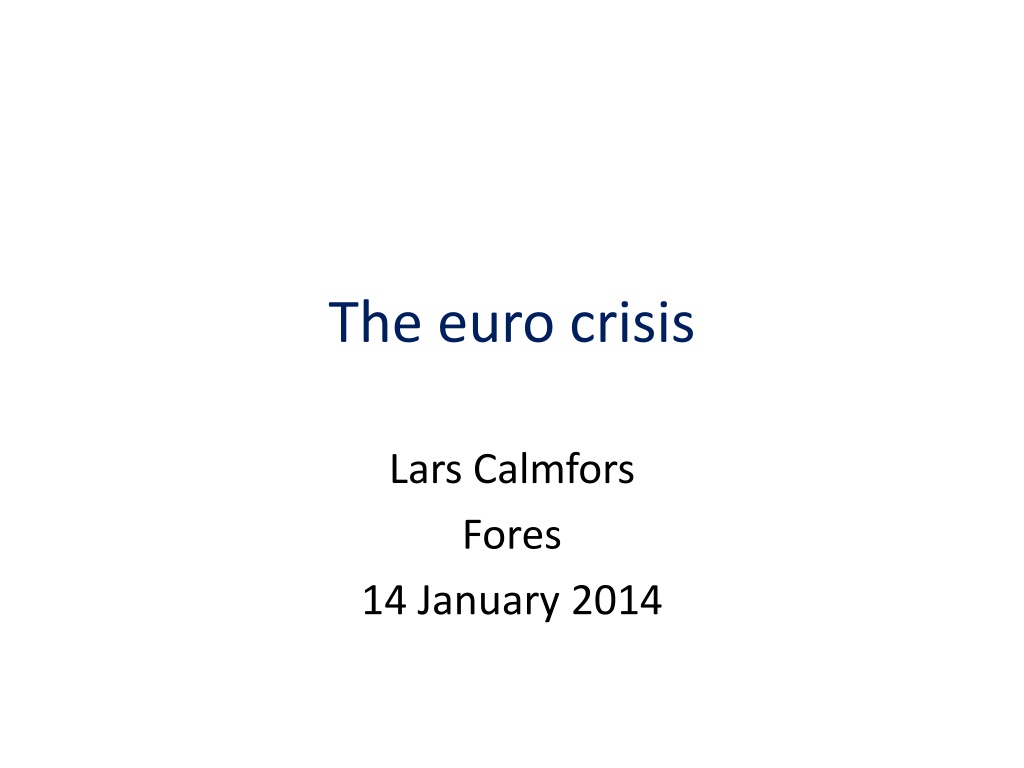Understanding the Euro Crisis: Interrelated Challenges and Strategies
The Euro crisis, analyzed through government bond yields, interrelated crises (sovereign debt, bank, growth, and competitiveness crises), government debt dynamics, and strategies to tackle sovereign debt crises with rescue loans and fiscal austerity conditions. The interconnected nature of the crises and the complexities in addressing them are highlighted.
Download Presentation

Please find below an Image/Link to download the presentation.
The content on the website is provided AS IS for your information and personal use only. It may not be sold, licensed, or shared on other websites without obtaining consent from the author. Download presentation by click this link. If you encounter any issues during the download, it is possible that the publisher has removed the file from their server.
E N D
Presentation Transcript
The euro crisis Lars Calmfors Fores 14 January 2014
Ten-year government bond yields, per cent 35 30 25 20 15 10 5 0 2008 2009 2010 2011 2012 2013 Germany Ireland Greece Spain Italy Cyprus Portugal
Four interrelated crises Sovereign debt crisis Bank crisis Growth crisis Competitiveness crisis
Interrelations between the crises Sovereign debt crisis and banking crisis - banking crisis triggered sovereign debt crisis (Ireland) - sovereign debt crisis aggravated bank crisis (Cyprus) Growth crisis and banking crisis - banking crisis exacerbated the recession - the recession aggravated the banking crisis Growth crisis and sovereign debt crisis - low growth has aggravated (triggered) debt crisis (Spain) - fiscal austerity to solve the debt crisis has caused low growth Competitiveness crisis and growth crisis - need for real depreciations - they require large employment losses
Government debt dynamics: mathematics
Government debt dynamics: verbal mathematics Change in the government debt ratio = (Primary fiscal deficit as a ratio to GDP) + (Nominal interest rate Nominal GDP growth rate) x (Initial government debt ratio) Government debt ratio = (Government debt)/GDP Primary fiscal deficit = Government expenditure less government revenues excluding interest payments
General government gross consolidated debt, per cent of GDP 200 180 160 140 120 100 80 60 40 20 0 1995 1996 1997 1998 1999 2000 2001 2002 2003 2004 2005 2006 2007 2008 2009 2010 2011 2012 2013 Ireland Greece Spain Italy Cyprus Portugal
Strategy to deal with the soverign debt crises Rescue loans plus conditions on fiscal austerity The objective is to turn the primary deficits into primary surpluses It is theoretically possible that fiscal tightening causes such a large fall in GDP, and thus in tax revenues, that the primary balance deteriorates This cannot be ruled out, although most estimates of fiscal multipliers imply that they are not sufficiently large for this to occur
Change in general government primary fiscal balance 2009-2013, per cent of GDP 10 8 6 4 2 0 IE LV LT RO ES UK PT SK FR CZ IT DE PL BG BE SL NL EE AT HU EL DK MT FI LU SE CY -2 -4 Change in primary balance Change in cyclically-adjusted primary balance
Short-run and long-run effects of fiscal tightening It is the strengthening (change) in the fiscal balance that is contractive, not remaining in a stronger position Once the effects of the change have occurred, capacity utilisation will gradually increase again But this requires price and wage adjustments Real depreciations must occur in the crisis countries Once the adjustment is completed, higher capacity utilisation will mean higher tax revenues Provided that the fiscal policy is sustained and is pushed far enough (so that primary deficits turn into primar surpluses) it will contribute to a falling government debt ratio
Changes in unemployment and labour costs relative to the euro area: Greece 20 10 0 -10 -20 -30 2008 2009 2010 2011 2012 2013 Arbetsl shet Relativ l nekostnad per anst lld Relativ enhetsarbetskostnad
Changes in unemployment and labour costs relative to the euro area: Spain 20 10 0 -10 -20 -30 2008 2009 2010 2011 2012 2013 Arbetsl shet Relativ l nekostnad per anst lld Relativ enhetsarbetskostnad
Primary fiscal balance, per cent of GDP (cyclically adjusted balance in parenthesis) 2012 2013 2014 -3.3 (-3.2) Cyprus -4.2 (-1.6) -4.3 (-1.5) Ireland -4.5 (-3.8) -2.8 (-2.3) -0.2 (-0.2) Greece -4.0 (1.8) -9.4 (-3.4) 2.8 (7.3) Italy 2.5 (4.3) 2.3 (4.8) 2.8 (4.8) Portugal -2.1 (-0.4) -1.6 (0.6) 0.3 (1.9) Spain -7.6 (-5.2) -3.3 (-0.9) -2.4 (-0.7) France -2.3 (-1.1) -1.8 (-0.2) -1.4 (0.2)
Change in nominal GDP, per cent 2012 2013 2014
Conclusions on the austerity strategy Eventually government debt ratios will begin to fall But it will take a long time until they return to more prudent levels - first the rises that have occurred during the fiscal adjustment period must be worked off Undesirable hardship for citizens during a very long period Huge political risks - support for the EU - trust in politicians at large - rises of populist (extremist) parties
Trust in the European Union and national governments and support for the euro Trust in the EU Trust in the national government Support for the euro Spring 2007 Autumn 2013 Spring 2007 Autumn 2013 Spring 2007 Autumn 2013 EU28 Eurozone 60 61 38 36 44 45 28 29 65 72 57 66 Austria Finland France Germany Netherlands 46 61 51 56 69 39 47 28 29 38 57 75 36 49 73 50 50 14 38 37 67 81 72 72 77 65 75 63 71 71 Cyprus Grece Ireland Italy Portugal Spain 61 63 54 58 65 65 17 21 34 23 25 21 64 41 41 37 46 52 26 10 17 10 15 9 50 47 88 67 64 68 44 62 70 53 50 56
Measures to facilitate adjustment More expansionary fiscal policy in the core (Germany) Higher wage cost increases in Germany - internal revaluation (higher employer contributions and lower income taxes) ECB should do more to keep inflation in the euro area at the target of two per cent The ECB could raise its inflation target to three och four per cent
Likely developments Unlikely that the fiscal austerity required for substantial government debt reductions in the crisis countries will be sustained Financial markets may buy the crisis countries government bonds for some time anticipating thay they can sell to the ECB But at some time there will again be a sudden stop The ECB then has to carry out actual purchases and/or the ESM to grant new loans
Need for debt forgiveness Substantial haircuts on outstanding debt - capital losses for the ESM and the ECB - capital losses for banks and bank failures - there would have to be resources for recapitalisation of banks - agreement on banking union does not provide for this Let the ECB buy government bonds from the crisis countries - exchange them for perpetual interest-free loans - in the short run no inflation risk, so this could be financed by printing money - in the longer term money supply increases must be sterilised - the ECB could issue interest-bearing debt or impose reserve requirements on banks - either way costs to citizens in core countries
Summing-up The euro crisis is not over The problem of unsustainable government debt in the crisis countries is not solved The fiscal austerity strategy carries large risks and is likely to be unsustainable Debt forgiveness is unavoidable Substantial haircuts now would be desirable but will not happen as the mechanisms for avoiding a banking crisis in such a situation do not exist Debt forgiveness will come in the future and in covert ways























